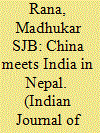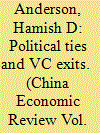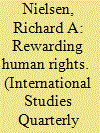|
|
|
Sort Order |
|
|
|
Items / Page
|
|
|
|
|
|
|
| Srl | Item |
| 1 |
ID:
131594


|
|
|
|
|
| Publication |
2013.
|
| Summary/Abstract |
This article attempts to conduct a comprehensive assessment of India and China's interests in Nepal in the wake of the drastic political Nepal since 2006. In this regard, the '6C- Frame of 1 as been employed in the context of Nepal, viz, 1) What are : interests of China and India?; it) What are their conflicting I) What are the areas of cooperation," (iv) What are the areas ' v) How do they diplomatically communicate their T vi) How do they diplomatically coordinate their interests cooperation and minimize con?ict?
|
|
|
|
|
|
|
|
|
|
|
|
|
|
|
|
| 2 |
ID:
159046


|
|
|
|
|
| Summary/Abstract |
We examine whether political ties (PTs) benefit VCs in China and find a positive relationship between PTs and successful VC exits. Our findings indicate that PTs are crucial for VCs to exit via Chinese mainland stock markets and M&As. The impact of PTs depends on the nature and compositions of PTs. We document that VCs with management-level PTs enjoy greater success than those with ownership-level PTs, whereas no significant difference between central and local government PTs on VC exits. Our results remain stable after controlling for selection bias, alternative measures for VC exits, and legal and institutional differences across regions.
|
|
|
|
|
|
|
|
|
|
|
|
|
|
|
|
| 3 |
ID:
133521


|
|
|
|
|
| Publication |
2014.
|
| Summary/Abstract |
Bangladesh and Myanmar share both land and maritime borders, and have age-old commercial and cultural ties. These two close neighbours have unlimited potentials in mutual cooperation in trade, connectivity and people to people contact. Both geostrategic and geoeconomic viewpoints justify the necessity of strong Bangladesh-Myanmar relations. Nevertheless, they have failed to best utilise their proximity and historical ties for economic and strategic gains. Since the establishment of the diplomatic tie in 1972, the relations have not always been smooth due to lack of political will especially from the Myanmar government, mutual misperceptions and suspicions. The Rohingya refugee issue, tensions in border and transnational crimes have been the key impediments to a meaningful bilateral relation. As consequences, many vital bilateral agreements and MoUs are pending. It is a reality that friends or allies may be changed but not neighbours. Therefore, the best interests of these close neighbours lie in exploring potential areas of cooperation and prosper together. This paper identifies several potential areas of mutual cooperation to explore and argues that for attaining a new height in Bangladesh-Myanmar relations, failure in resolving any hard issue such as the refugee issue should not be allowed to leave any negative impact on other prospective areas. Exploring the potential areas and trying to resolve the key disputes through various channels can be done simultaneously. For greater friendship, removing suspicions and opening up minds are imperative for these neighbours.
|
|
|
|
|
|
|
|
|
|
|
|
|
|
|
|
| 4 |
ID:
133519


|
|
|
|
|
| Summary/Abstract |
Bangladesh and Myanmar share both land and maritime borders, and have age-old commercial and cultural ties. These two close neighbours have unlimited potentials in mutual cooperation in trade, connectivity and people to people contact. Both geostrategic and geoeconomic viewpoints justify the necessity of strong Bangladesh-Myanmar relations. Nevertheless, they have failed to best utilise their proximity and historical ties for economic and strategic gains. Since the establishment of the diplomatic tie in 1972, the relations have not always been smooth due to lack of political will especially from the Myanmar government, mutual misperceptions and suspicions. The Rohingya refugee issue, tensions in border and transnational crimes have been the key impediments to a meaningful bilateral relation. As consequences, many vital bilateral agreements and MoUs are pending. It is a reality that friends or allies may be changed but not neighbours. Therefore, the best interests of these close neighbours lie in exploring potential areas of cooperation and prosper together. This paper identifies several potential areas of mutual cooperation to explore and argues that for attaining a new height in Bangladesh-Myanmar relations, failure in resolving any hard issue such as the refugee issue should not be allowed to leave any negative impact on other prospective areas. Exploring the potential areas and trying to resolve the key disputes through various channels can be done simultaneously. For greater friendship, removing suspicions and opening up minds are imperative for these neighbours.
|
|
|
|
|
|
|
|
|
|
|
|
|
|
|
|
| 5 |
ID:
133520


|
|
|
|
|
| Summary/Abstract |
Bangladesh and Myanmar share both land and maritime borders, and have age-old commercial and cultural ties. These two close neighbours have unlimited potentials in mutual cooperation in trade, connectivity and people to people contact. Both geostrategic and geoeconomic viewpoints justify the necessity of strong Bangladesh-Myanmar relations. Nevertheless, they have failed to best utilise their proximity and historical ties for economic and strategic gains. Since the establishment of the diplomatic tie in 1972, the relations have not always been smooth due to lack of political will especially from the Myanmar government, mutual misperceptions and suspicions. The Rohingya refugee issue, tensions in border and transnational crimes have been the key impediments to a meaningful bilateral relation. As consequences, many vital bilateral agreements and MoUs are pending. It is a reality that friends or allies may be changed but not neighbours. Therefore, the best interests of these close neighbours lie in exploring potential areas of cooperation and prosper together. This paper identifies several potential areas of mutual cooperation to explore and argues that for attaining a new height in Bangladesh-Myanmar relations, failure in resolving any hard issue such as the refugee issue should not be allowed to leave any negative impact on other prospective areas. Exploring the potential areas and trying to resolve the key disputes through various channels can be done simultaneously. For greater friendship, removing suspicions and opening up minds are imperative for these neighbours.
|
|
|
|
|
|
|
|
|
|
|
|
|
|
|
|
| 6 |
ID:
126579


|
|
|
|
|
| Publication |
2013.
|
| Summary/Abstract |
This article provides theoretical and empirical solutions to two connected puzzles in the study of foreign aid and human rights: Do foreign aid donors use aid sanctions to punish repressive states, and if so, why? I show that donors impose aid sanctions selectively. Aid sanctions typically occur when repressive states do not have close political ties to aid donors, when violations have negative consequences for donors and when violations are widely publicized. Using a data set of bilateral foreign aid to 118 developing countries between 1981 and 2004, I find that variation in these factors largely accounts for the differing aid sanctions that result from objectively similar rights violations by the governments of developing countries.
|
|
|
|
|
|
|
|
|
|
|
|
|
|
|
|
|
|
|
|
|